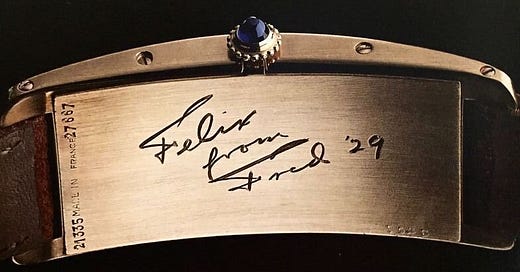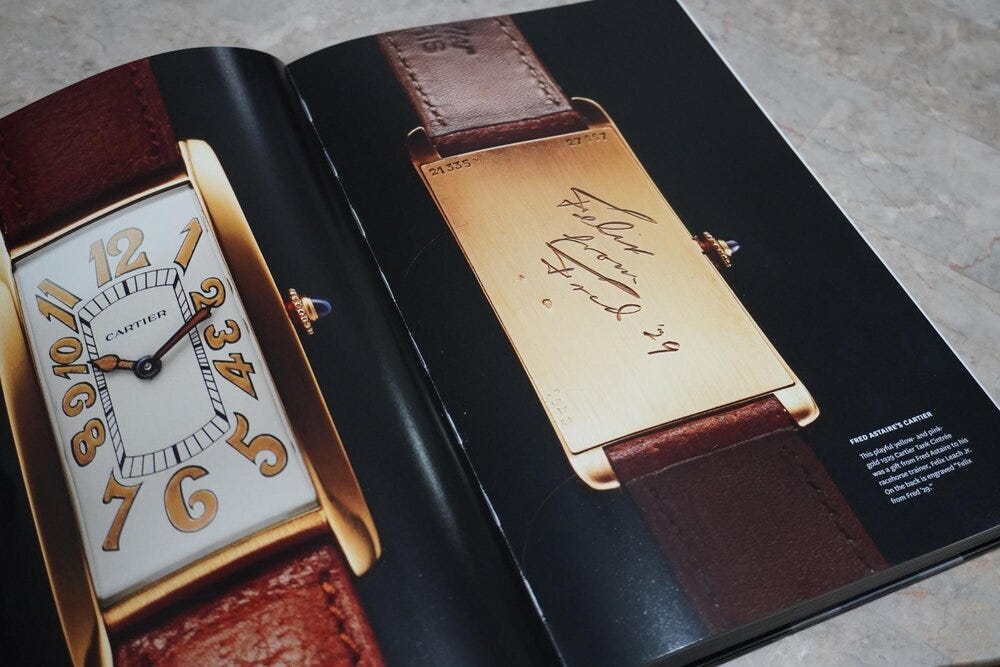'Felix from Fred '29': The true story of the Cartier Tank Cintrée and Fred Astaire
The luminous London Tank Cintrée gifted from Fred Astaire to Felix Leach Jr.
An in-depth exploration of the Cartier Tank Cintrée gifted by Fred Astaire; horology as art with seconde/seconde/.

By: Charlie Dunne
The Luminous London Cintrée gifted from Fred Astaire to Felix Leach Jr.
[Note: This is an in-depth exploration of the true story behind the “Fred Astaire” Cartier Tank Cintrée. Click the above link for the full piece and all images.]
The fascination with what performers wear on their wrists is not only something that we focus on today, but also an integral part of how brands position themselves to consumers. Whether or not an association to people within the public eye influences a purchase, it undoubtedly adds to a brand’s prestige. But does the celebrity association add any value to the watch other than in the strict monetary sense? And more importantly, can the manner in which we echo the common conjecture about such associations diminish the historical accuracy?
The common narrative surrounding the Cartier Cintrée watch “owned by Fred Astaire” and engraved “Felix from Fred ‘29” is one such association that misses the mark. In reality, the watch was owned by Felix Leach Jr., an English jockey and horse trainer from Newmarket whose story has yet to have been told, gifted to him by Astaire in 1929, an important year in the jockey’s life.
👉 Rescapement is a weekly newsletter about watches. Subscribe now to get it delivered to your inbox every Sunday.
Fred Astaire
Frederick Austerlitz, more commonly known as Fred Astaire, was born in Omaha, Nebraska in 1899. At an early age, Fred and his sister, Adele, developed a strong passion for dancing. By the age of six, Fred graduated to a professional performer. The siblings would soon go on to be featured in musicals throughout their teenage years.

In addition to being a celebrated performer, Astaire loved horse racing. While performing in England, he became entranced by the thoroughbred racing scene. Upon returning to the United States in 1933, he would purchase the Blue Valley Ranch in Chatsworth, California. Over the course of the following decades, he would spend his time offstage at the ranch, dedicating his time to horses.
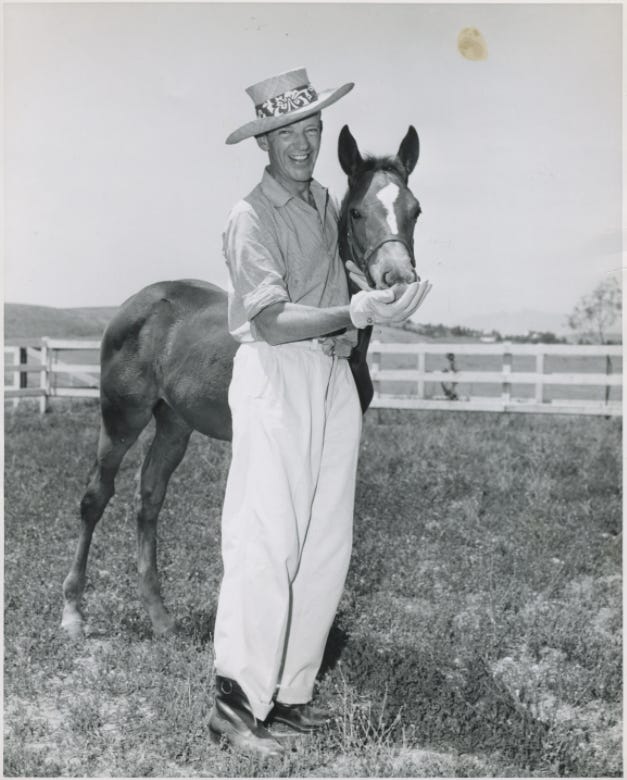
The Leach Family
Newmarket, Suffolk is home to England’s largest racehorse training center and is internationally recognized as the “birthplace of thoroughbred horse racing.” Felix Walmough Leach Sr. was a prominent horse trainer in Newmarket. Born in Wigan in 1876, Leach’s family developed a strong reputation in the area due to his own training acumen along with his three sons, each of whom were jockeys.
From 1926-1931, Fred Astaire spent much of his time performing back and forth from the States to England. A regular in the Newmarket social scene, he was one to indulge the locals in impromptu performances and dancing on the mantelpieces of local clubs when placing £5 bets. It was during this period he purchased a stable in the country. He would soon go on to purchase several horses, each of which would be trained in Newmarket by Felix Leach Jr.
Felix Leach Jr.

Whereas his younger brothers were distinguished in their racing careers, Felix Leach Jr., unfortunately, did not see the same success. Born in 1899, Felix Leach Jr. pursued his ambitions to add to the family business by racing. It was around the age of 21 that he began to show aptitude as a jockey during his apprenticeship under his father. Felix Jr. would compete in his highest-stakes races on the stallion Orpheus in 1920. The pair placed third in The Derby Stakes, then went on to win The Champion Stakes.
The standard weight for jockeys is around 110lbs. Due to Felix’s gaining weight in his early 20s, he transitioned to focus on training. By age 26, Felix Jr. would get married. His highest achievement as a trainer came on November 22, 1930, when trainee Tommy Atkins won the Ayr Gold Cup. Tragically, five days later Felix Jr. became ill and was forced to undergo an emergency appendix operation. He would pass away as a result of the surgery.
“The racing world was [well represented] at the funeral of Felix Leach [Jr.]. Prominent owners, trainers and Jockeys paid their last tribute to the deceased, who had proved himself a good Jockey, trainer and citizen during his short life of 31 years.”
- The Telegraph Sat Jan. 17, 1931
It was reported that Felix Jr.’s funeral was attended by over 400 individuals, a testament to the family’s position within the community. Along with his devastating passing, he left behind a newborn son of just a few months.
About the Tank Cintrée
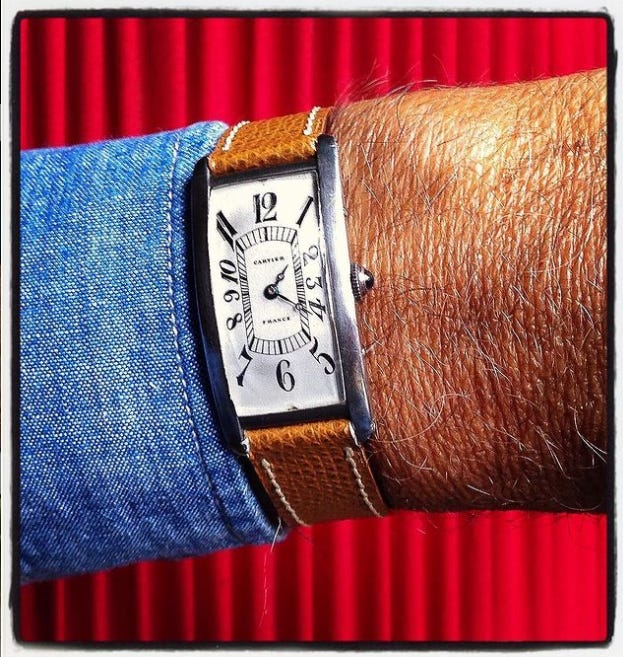
The Cartier Tank Cintrée dates back to 1921, a period in which rectangular watches were the standard. While designed a century ago, the timepiece is likely to be eternally relevant on the wrist, simultaneously capturing the hearts of those both deeply obsessed or novitiates.
Most examples are predominantly decorated with roman numerals; however, the timepiece that “belonged to Fred Astaire” features a radium dial. In Cartier: The Tank Watch Franco Cologni cites that occasionally Tanks would feature luminous hour markers and hands from 1925 on, but they are certainly atypical, amongst examples that are already few and far between. As in the original Tank Cintrée, the example engraved with “To Felix from Fred” features what Martin Green has described as a “plump sapphire cabochon” with a beaded crown.
The “Astaire” Cintrée: Telling the story
![On view at SIHH 2018. Caption: “[Above] the watch that apparently belonged to Fred Astaire and sits now in the Cartier private collection. London Cartier 1922.” | Image credit: Le Monde Edmond On view at SIHH 2018. Caption: “[Above] the watch that apparently belonged to Fred Astaire and sits now in the Cartier private collection. London Cartier 1922.” | Image credit: Le Monde Edmond](https://substackcdn.com/image/fetch/w_1456,c_limit,f_auto,q_auto:good,fl_progressive:steep/https%3A%2F%2Fbucketeer-e05bbc84-baa3-437e-9518-adb32be77984.s3.amazonaws.com%2Fpublic%2Fimages%2Faac0da64-a3d9-4ca5-afb2-947c50ebcc84_1000x752.jpeg)
In an interview with Wei Koh of Revolution, Auro Montanari commented on the Cintrée that “belonged to Fred Astaire”, stating:
“It’s a great watch. The problem is the watch was purchased at auction a long time ago by Cartier with the original Radium numerals and they restored it, because it is very difficult to still keep a radium dial in the collection and they did a good job. They made the exploded numerals like the original and they show it in their museum.”
The timepiece associated with Astaire has been actively showcased over the years in traveling exhibitions by Cartier. In 2009, Cartier celebrated its 100 year anniversary in the United States through its exhibition Cartier and America hosted at the Legion of Honor (Fine Arts Museums of San Francisco). Curated by Martin Chapman, the museum featured the commissioned jewelry, clocks, watches, and accessories of prominent American patrons to the Maison.
The “Astaire” Tank Cintrée also featured in the 2017 exhibition “Cartier in Motion”, curated by Norman Foster.
Restoration
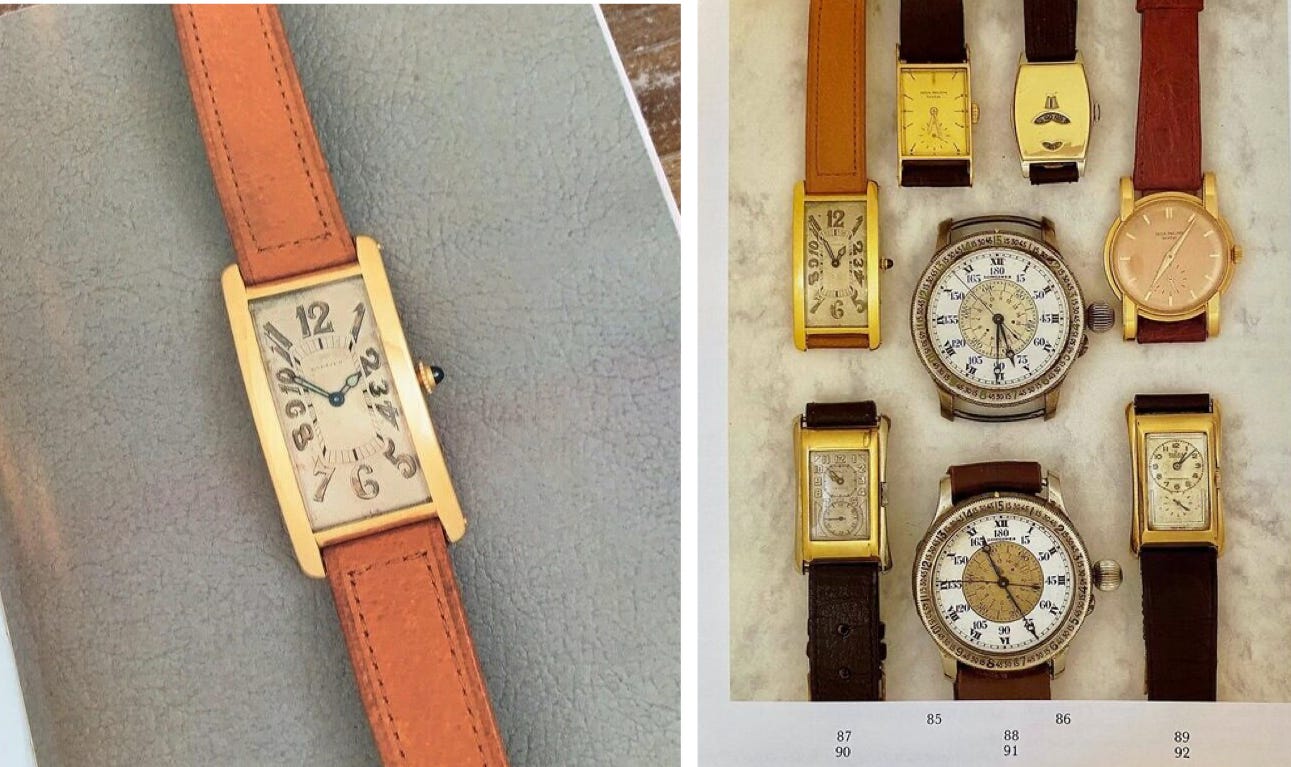
The 1989 publication Cartier: A Century of Cartier Wristwatches George Gordon was among the first to document the watch and noted the provenance with the caption “Men’s rectangular curved Tank Cartier wristwatch, presented by Fred Astaire, circa 1928”. It was an era void of information and resources, leaving those on the scene only equipped with their experience and best judgment.
When asked for comment on the Cartier, Gordon confirmed that he was briefly the owner and that it was sold at auction around the time of his publication in the late 1980s. In a later Cartier publication, the watch is noted to have been sold at Sotheby’s London in July of 1988. As seen within the catalog and upon its cover, the watch was sold with its original dial.
It is unclear whether the watch was purchased by Cartier at auction; however, Vogue has indicated that it has been in its collection since 1988. Nevertheless, the watch eventually found its way into the D. Walsh Collection and the original dial was restored.
Things can become a bit personal when you add the element of radium. Today, some collectors have health concerns due to the potential exposure to radium, while others simply love the dials. It’s possible the decision to restore the Cintrée’s dial may have stemmed from these safety concerns, as the watch has been toured and placed on the wrists of enthusiasts around the world.
A more likely scenario behind the dial’s restoration is purely aesthetic. In the period of its sale, the adamancy for untouched cases and original dials was not as pronounced as it is today. In some instances, certain brands remain disreputable with the task of servicing their own watches to this day. Regardless, the Cartier image and perception is very much one of refined luxury. This brand image differs from say, Longines, in that they can embrace a “damaged dial” within their museum due to the fact these timepieces were utility-based in aviation and other fields (I know, #SorrySantos). So this raises the question of whether the decision was appropriate in hindsight.
Watch collectors have differing opinions when it comes to restoration, and the topic becomes a bit more emotional when rare and/or historically significant timepieces are involved. In regards to a watch such as this Cintrée, undoubtedly we will see polarizing viewpoints. While perhaps the argument could be made that the dial, in original condition, did not fit within the Cartier aesthetic, the counterargument would strongly appeal to the importance of preservation. After all, when factoring in the rarity of vintage Cartier timepieces, let alone those with luminous hour markers and hands, the examples are extremely rare.
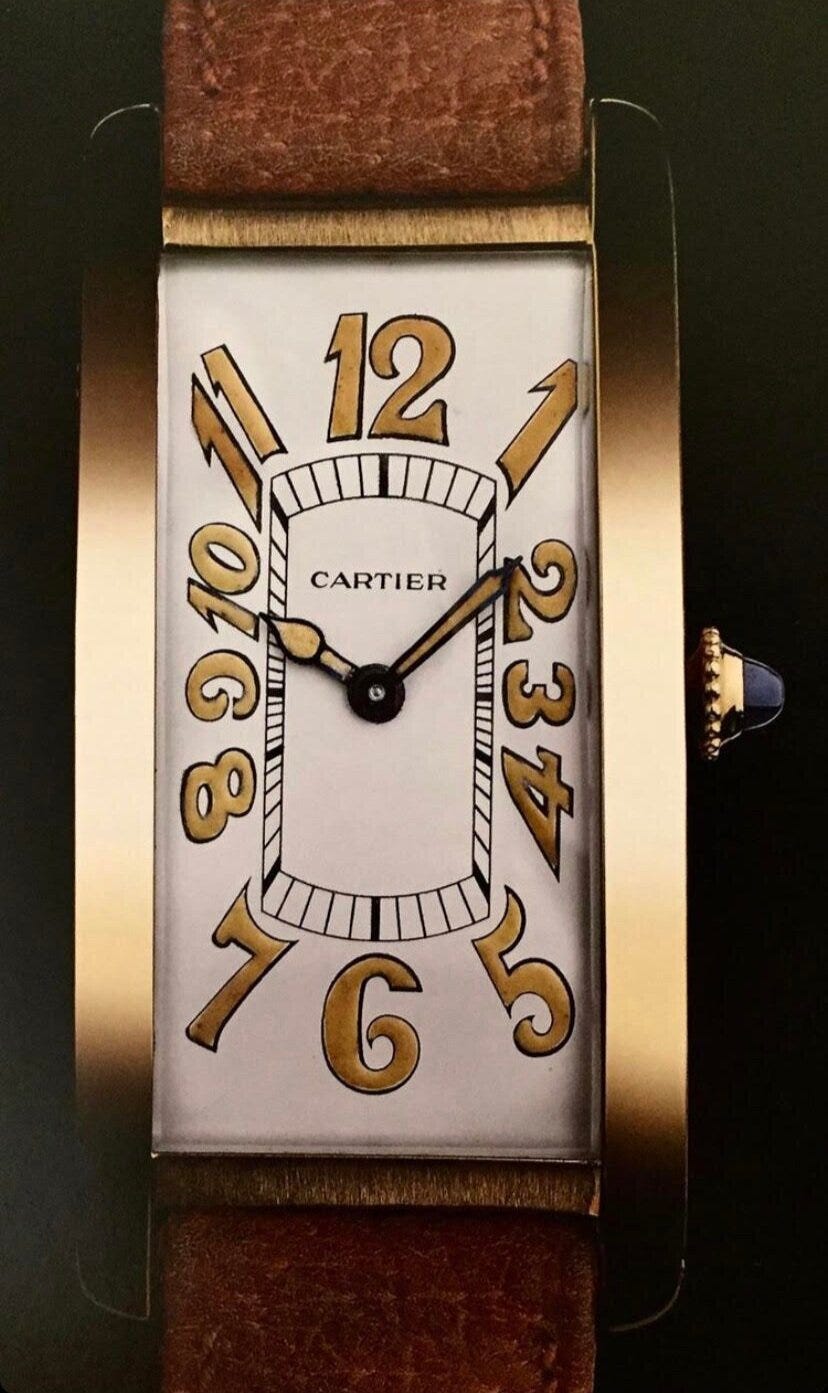
There are alternative approaches we have seen in recent years from brands that show true respect for the artifacts within their companies’ history. One such example is seen with the Vacheron Constantin 'Don Pancho' which was auctioned off at Phillips in 2019. Like the Felix Leach Jr. watch, the historically significant minute repeater was in fact born with a radium dial and hands (in addition to a dressier, non-luminous version). Unsurprisingly, over the course of its 80-year life the dial was compromised to the extent it would have hindered most prospective buyers from purchasing the timepiece. Yet Vacheron Constantin and Phillips understood this watch’s importance, not only for this auction, but for future owners. The original dial was preserved and sold with a manufactured replacement dial to allow the watch to remain as original as possible.
Concluding thoughts

Is the prestige of a watch greater based upon who wore it? Sure. Is the prestige of said watch brand lost by clarifying common misconceptions or misinterpretations? I say no. It’s possible that Cartier doesn’t care to correct these whether they are intentional or unintentional. And let’s face it, many watches benefit from an embellished framing. Whether in auction, museums, or private collections, there are a lot of dressed-up narratives around watches in order to elevate the price, brand history, or collector.
The inscription “Felix From Fred ‘29” on the Cartier’s caseback still leaves much to be answered. According to Felix Leach Junior’s memorial, 1929 was a significant year for him as a trainer winning 34 races. While it is not clear as to the specific reasoning behind Astaire’s gift, the plausible explanation coincides with the expectation of Felix Jr.'s first born. Considering the birth of his son in the months preceding his untimely death, and Astaire being the best man at his brother Jack’s wedding in late 1928, it is evident that the group was much closer than simply acquaintances through horseracing. The Cartier Cintrée was very likely gifted to Felix Jr. in recognition of the birth of his firstborn child.
The common conjecture around the timepiece “owned by Fred Astaire” is a bit disappointing. Not because it is disingenuous, but rather because it neglects to acknowledge the thoughtfulness that is embodied within the timepiece. Beyond the marketing, the story of a timepiece’s pedigree should be worthy of recognition. In a period in which few people had the means of acquiring a Cartier timepiece, let alone to have been given one from Fred Astaire, there seems to be a disconnect on why the watch is more than simply something Fred Astaire “owned”.
With vintage timepieces, and in particular, timepieces with provenance, the value is not strictly on the appearance being exemplary. These are, in many people's opinions, important artifacts that deserve not only to be kept in as original condition as possible, but also accurately described. Hopefully, the Felix Leach Jr. timepiece can be seen as more than just a spectacle of luxury. By entertaining the current narrative, we miss the story at hand, and the next chapter.
Acknowledgments: A very special thank you to Auro Montanari (@goldberger) for his invaluable assistance and for sharing his photographs of the engraved caseback for this article.
Head to “Felix from Fred ‘29” for the full article.
French Revolution: Seconde/Seconde/
Are watches art? It’s an oft-debated, slightly irritating question: To answer in the affirmative is to imply that there are artists using watches as a medium of expression and creativity to explore new ideas.
“I feel more and more comfortable saying I’m an artist,” says Romaric André, the founder of Paris-based (Design studio? Art studio? Vintage dealer? “I play with hands on vintage watches”, Romaric modestly puts it with a mischievous smile) Seconde/Seconde/. “But that puts some pressure on me to say I won’t do anything that’s not true to me as an artist. An artist has to say ‘fuck the convention, fuck the norm.’ I want to be edgy. I don’t want to do the simple things.”
With the April Fool’s but very real release of the Endeavour x Seconde/Seconde/, I wanted to re-post our story from last year on Romaric André and Seconde/Seconde/.
👉 Meet the Han Solo of vintage watches, fighting to make art of patina.
Rescapement is a weekly newsletter about watches, mostly vintage. Subscribe now to get it delivered to your inbox every Sunday. Follow us on IG too.


